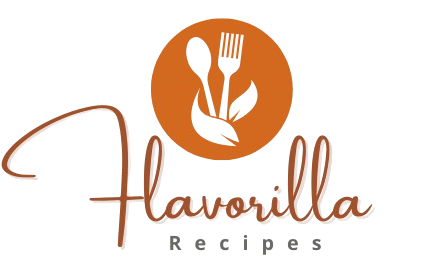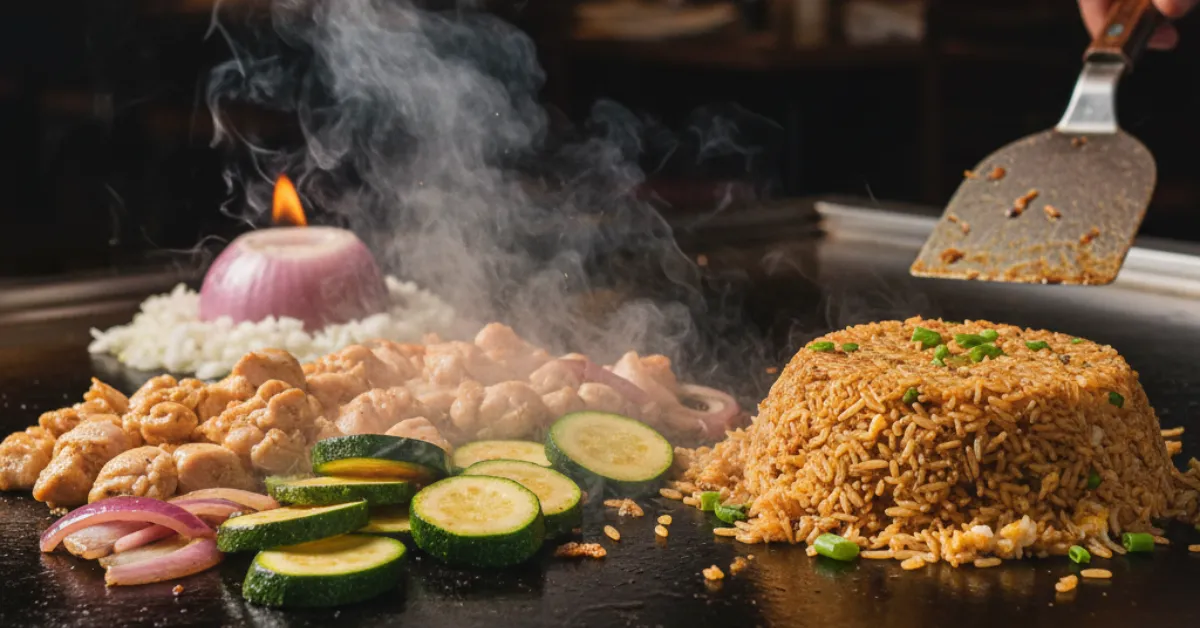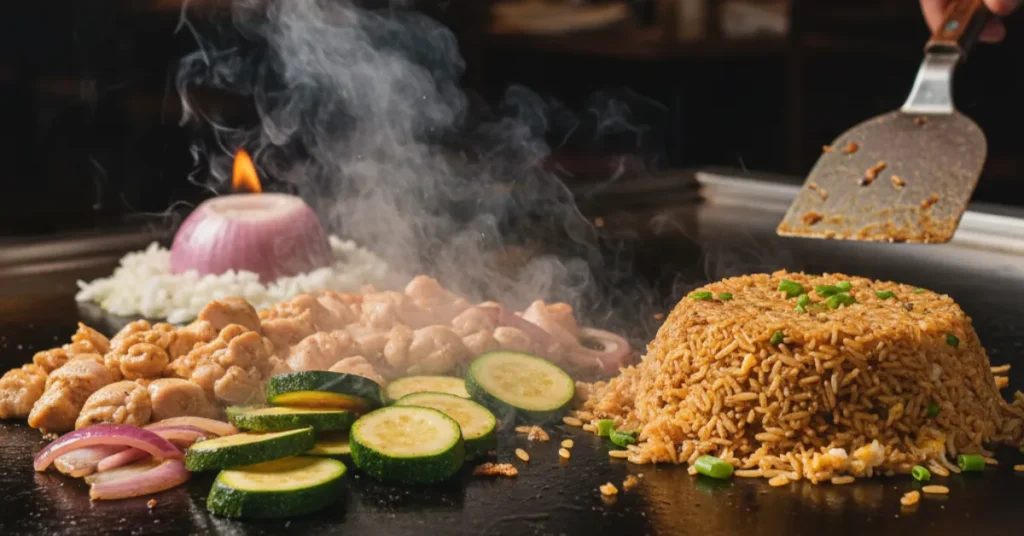
Admit it: you’ve spent half your last birthday dinner mesmerized by a chef chopping, flipping, and juggling shrimp on a hot grill. What if I told you that iconic Japanese steakhouse experience—the one with the incredible smells and the even better food—is actually easy to replicate in your own kitchen? Well, it is! Stop paying premium prices for dinner and let’s get that sizzle going.
This ultimate **hibachi recipe** is your VIP pass to the flavor show. We’re not just talking about searing some chicken; we’re talking about mastering the high-heat cooking technique, perfecting that savory **hibachi fried rice recipe**, and, yes, finally cracking the code on that addictive white sauce (Yum Yum Sauce) you crave.
This dish is incredibly quick, surprisingly healthy, and so much fun to make, it feels like a weeknight indulgence. Get ready to impress your friends—your kitchen is about to become the hottest new restaurant in town!
- Why You’ll Love This Recipe
- Ingredients
- Instructions
- You Must Know
- Storage Tips
- Ingredient Substitutions and Variations
- Serving Suggestions
- Cultural and Historical Notes
- Seasonal Adaptations
- Three Helpful Notes about This Recipe
- Success Stories
- Freezer Meal Conversion
- Pro Tips
- Common Recipe Questions
- What You’ll Need
- Steps to Follow
- Extra Handy Tips
- Tools You’ll Need
- Allergy Details
Why You’ll Love This Recipe
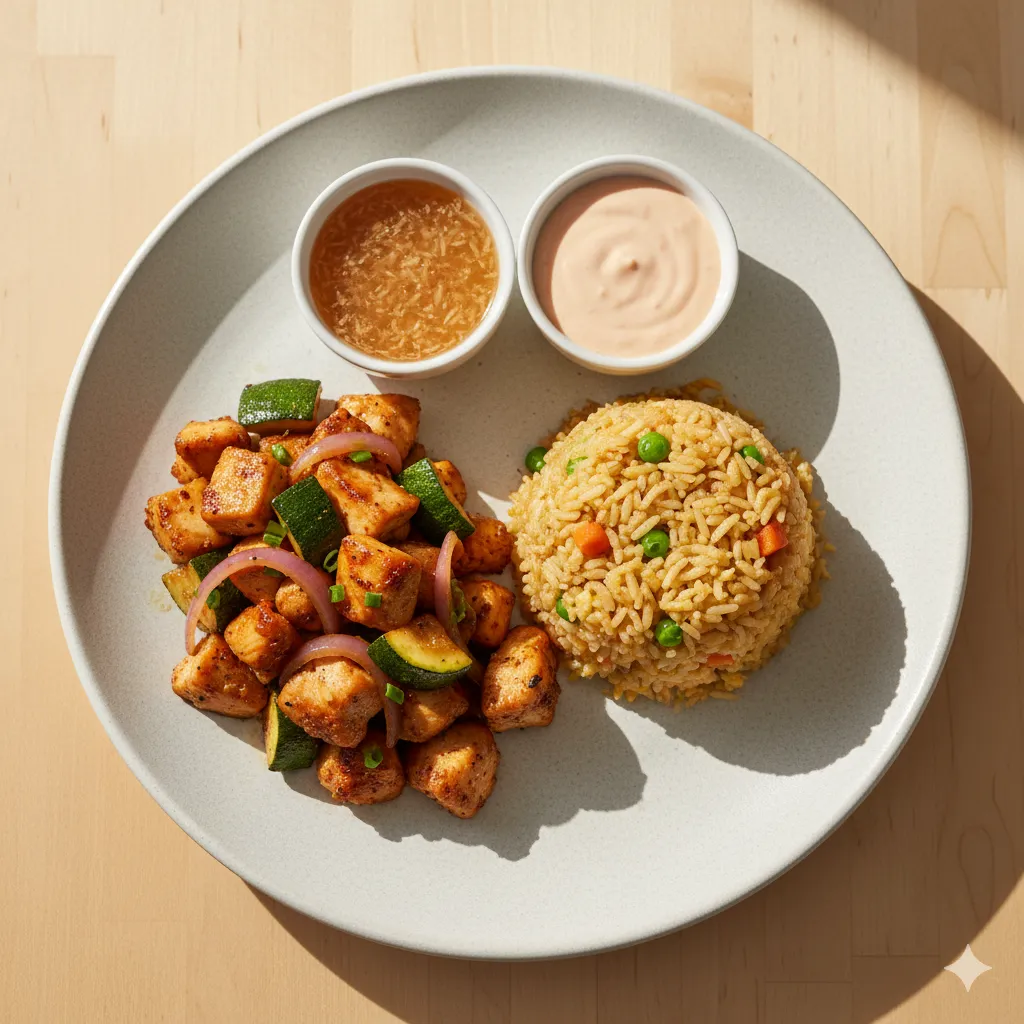
- **Authentic Flavor at Home:** We use the exact techniques and ingredients (hello, garlic butter!) that deliver that unmistakable, smoky hibachi taste.
- **Lightning Fast:** Everything cooks over high heat, meaning your dinner is ready in under 35 minutes, making it a perfect **quick recipes** option.
- **Master the Sides:** This guide includes the secrets to perfect **hibachi fried rice recipe** and the essential dipping sauces.
- **Customizable Protein:** Easily swap the **hibachi chicken recipe** for steak, shrimp, or tofu.
Ingredients
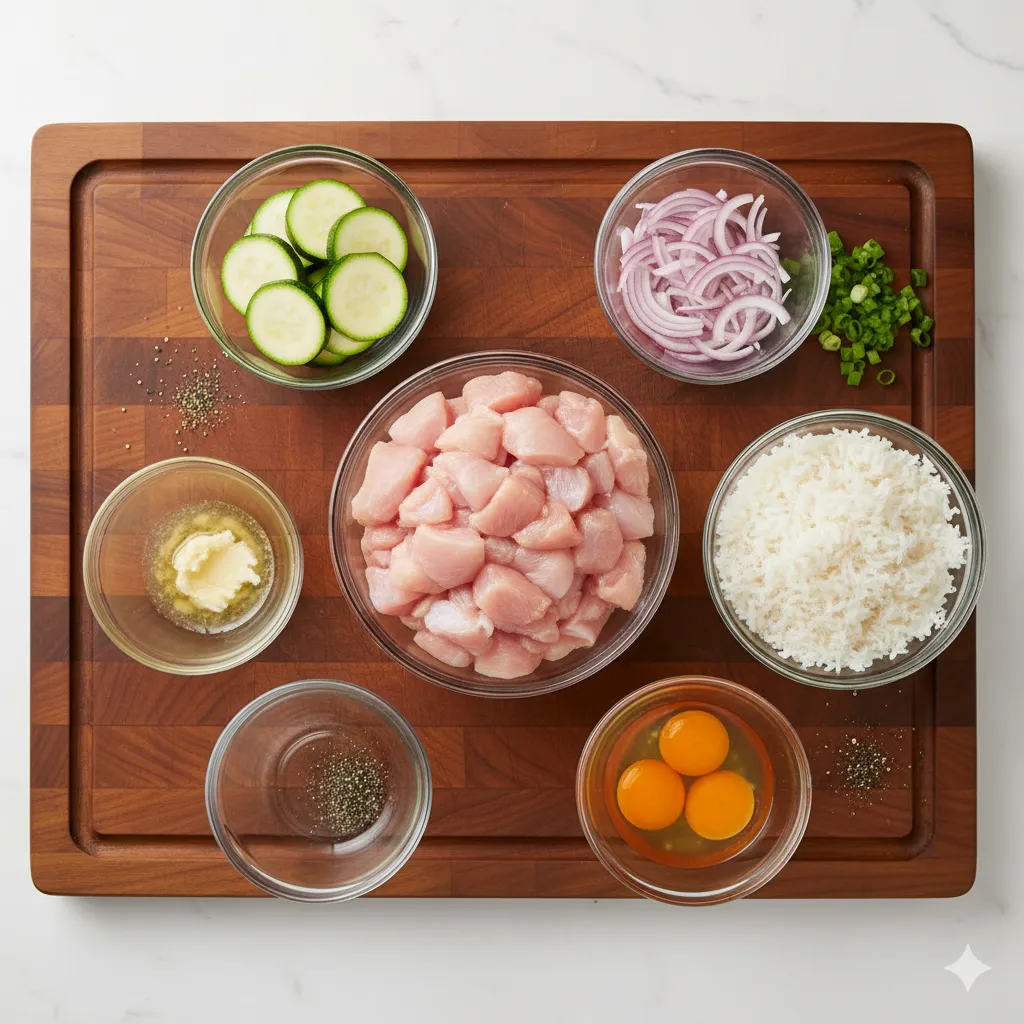
The core of a great **hibachi recipe** is freshness and simplicity. The ingredients list is straightforward, but the preparation—especially the day-old rice—is key to achieving that restaurant-quality texture.
- **Protein:** Boneless, skinless chicken breasts or thighs, cut into 1-inch cubes.
- **Vegetables:** Zucchini (the classic!), yellow onion, and matchstick carrots.
- **Fat:** Both butter and a high-heat oil like vegetable, canola, or avocado oil are necessary for the sizzle and flavor.
- **Fried Rice Base:** Day-old cooked white rice is non-negotiable! Fresh rice turns mushy.
- **Seasonings:** Soy sauce, sesame oil, garlic powder, salt, and pepper.
For the famous Yum Yum Sauce (which complements every **hibachi recipe**): Mayonnaise, sugar, ketchup, rice vinegar, and water to thin it out.
Instructions
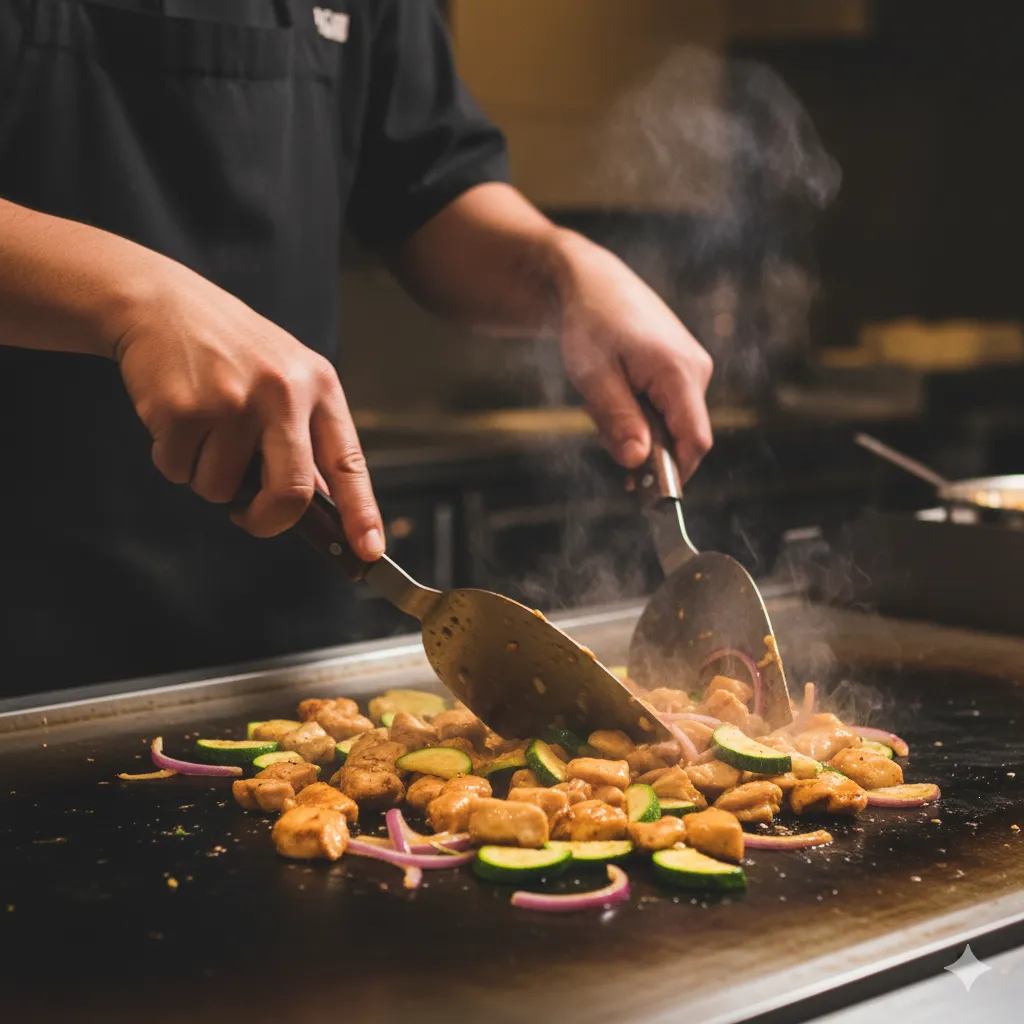
1. Prepare and Marinade:
Cube your chicken and place it in a bowl. Toss it with one tablespoon of soy sauce, a teaspoon of sesame oil, and half a teaspoon of garlic powder. Set it aside to lightly marinate while you chop the vegetables. Cube the zucchini and slice the onion and carrots.
2. Cook the Protein and Veggies:
Heat your largest skillet or flat-top griddle over high heat. Add two tablespoons of butter and one tablespoon of oil. Once sizzling, add the marinated chicken and cook for 5-7 minutes, until beautifully golden brown and fully cooked through. Push the chicken to the side of the pan. Add the remaining butter to the empty spot, then toss in the zucchini, onions, and carrots. Cook for about five minutes until they are tender-crisp, seasoning lightly with salt and pepper.
3. Make the Fried Rice:
Clear another spot on the griddle and add one tablespoon of oil. Add the day-old rice, breaking it up quickly with a spatula. Pour a quarter cup of soy sauce over the rice and toss to coat. Push the rice to one side.
4. Add Egg:
Pour the two scrambled eggs onto the empty cooking area. Let them set for about 30 seconds, then chop and quickly mix them into the fried rice. Combine all ingredients on the griddle—chicken, vegetables, and rice—and give one final, quick stir to bring all the delicious elements of your **hibachi recipe** together.
5. Serve:
Serve the hibachi chicken, vegetables, and fried rice immediately. Don’t forget a generous portion of Yum Yum Sauce and ginger sauce (if using) for dipping!
You Must Know
The success of any authentic **hibachi recipe** lies almost entirely in the use of high heat and a generous amount of fat, specifically butter. You are not sautéing; you are flash-frying and searing. This is what creates that signature caramelized flavor and slightly crispy texture. You need a large surface area (like a flat-top or a huge skillet) that can get piping hot and stay hot once the food hits it.
The intense heat instantly caramelizes the natural sugars in the vegetables and creates a beautiful crust on the protein. Don’t crowd the pan! If you’re cooking for more than two people, it is far better to cook the chicken or steak in two separate batches to ensure the temperature of the pan doesn’t drop, which would lead to steaming rather than searing.
Furthermore, the fried rice must be made with chilled, day-old rice because the starch structure changes overnight, making it less sticky and allowing it to crisp up beautifully when fried, which is the key to differentiating a restaurant-style **hibachi rice recipe** from regular homemade fried rice. Do not attempt this with freshly cooked rice unless you enjoy a sticky, gummy mess—you’ve been warned!
Storage Tips
Store all components of the **hibachi recipe**—the chicken, vegetables, and fried rice—together in an airtight container in the refrigerator for up to 3 days. The Yum Yum Sauce should be stored separately in a sealed container in the fridge for up to 5 days. Hibachi is best when reheated quickly on the stovetop or flat-top grill to revive the crispy texture, avoiding the microwave if possible.
Ingredient Substitutions and Variations
This **hibachi recipe** is incredibly flexible. For a delicious alternative, try the **hibachi chicken recipe** with cubed sirloin steak or large shrimp. You can easily adapt this to be a **hibachi recipes blackstone** method—the griddle is perfect for this high-heat cooking style. For a low-carb alternative, replace the rice with riced cauliflower. For an extra layer of richness, incorporate chopped scallions and a pinch of ground ginger into the fried rice. If you don’t have zucchini, broccoli florets or sliced mushrooms make great additions. For another amazing Asian-inspired dish, check out our delicious Lomo Saltado Recipe. For more professional cooking and health tips, you can explore resources from Serious Eats.
Serving Suggestions
The full hibachi dinner includes the protein, vegetables, and **hibachi fried rice recipe** alongside two key dipping sauces: the creamy Yum Yum Sauce (white sauce) and the thin, savory ginger sauce. Serve it all family-style so everyone can customize their plate. A side of Japanese clear onion soup or a light green salad with a ginger dressing completes the experience.
Cultural and Historical Notes
The term “hibachi” in English-speaking countries is commonly used to describe *teppanyaki* style cooking, where food is prepared on a flat, iron griddle (teppan) in front of the diners. True Japanese *hibachi* actually refers to a traditional heating device, typically a ceramic or metal open container used for holding charcoal. However, the American-style hibachi restaurant, made famous in the mid-20th century, focuses on the showmanship of the teppanyaki chef. This **hibachi recipe** recreates the flavor profile of the teppanyaki steakhouse experience, making it accessible for any home cook, regardless of whether they have a traditional *teppan* or a simple skillet.
Seasonal Adaptations
The classic hibachi vegetables (zucchini and onion) are available year-round. However, in the spring, consider adding tender asparagus spears to your **hibachi recipe**. In the fall, a quick sauté of thin-sliced bell peppers can add a nice crunch and color.
Three Helpful Notes about This Recipe
- Always use **day-old rice** for the **hibachi fried rice recipe**; it prevents clumping.
- The high heat is critical—if your pan isn’t sizzling when the food hits it, wait longer!
- The secret flavor is the use of both butter and oil; butter for flavor, oil for heat stability.
Success Stories
This **hibachi recipe** is one of our most successful copycat meals. Readers often comment on how much money they save by not going out, and how easy it is to make huge batches for family dinners. The most common praise is for the perfect **hibachi rice recipe** texture and the surprising accuracy of the Yum Yum Sauce. It’s a guaranteed winner for a fun and flavorful night!
Freezer Meal Conversion
The cooked protein (chicken, shrimp, or steak) can be frozen for up to 3 months. Cook the protein fully, let it cool, and store it in a freezer-safe bag or container. The rice and vegetables are best cooked fresh, but for meal prep convenience, you can freeze individual portions of the cooked **hibachi fried rice recipe**. Thaw and reheat the rice on the stovetop with a little more butter to bring back its crispness.
Pro Tips
- To create the iconic “volcano” onion stack, slice a large onion into thick rings and stack them, filling the center with a small amount of oil, then ignite carefully! (For advanced cooks only).
- For the best **hibachi chicken recipe**, dice the chicken into uniform pieces to ensure even cooking.
- Don’t stir the food constantly—allow the protein and vegetables time to sear and develop a brown crust before flipping.
Common Recipe Questions
hibachi chicken recipe
The best **hibachi chicken recipe** starts with cubed chicken seasoned with soy sauce, sesame oil, and garlic powder. It is cooked quickly over very high heat with butter and garlic, often on a flat-top grill or in a large skillet, until it is tender and slightly caramelized.
hibachi fried rice recipe
A great **hibachi fried rice recipe** requires day-old rice to prevent stickiness. It is cooked over high heat with butter, oil, eggs, and a light seasoning of soy sauce, often incorporating finely diced vegetables like carrots and onions.
how to cook hibachi vegetables recipe
**Hibachi vegetables** (like zucchini and onions) are cooked over very high heat in a mixture of butter and oil, with a quick toss of salt, pepper, and sometimes garlic. The goal is a tender-crisp texture with a slight char, cooked very fast to maintain their freshness.
hibachi recipes blackstone
**Hibachi recipes blackstone** style are perfect for a griddle. The large, flat surface allows you to cook all the components—the chicken, vegetables, and fried rice—simultaneously at high heat, mimicking the professional teppanyaki cooking style.
how to cook like a hibachi shrimp sauce recipe
The classic ‘hibachi shrimp sauce’ is the popular **Yum Yum Sauce**, a creamy, sweet, and tangy mayonnaise-based dressing. It’s easily made at home with ingredients like mayonnaise, sugar, ketchup, rice vinegar, and water.
What You’ll Need
→ Protein and Marinade
1 lb boneless, skinless chicken breast or thighs, cubed
1 tbsp soy sauce
1 tsp sesame oil
1/2 tsp garlic powder
→ Vegetables
1 large onion, sliced
2 zucchini, sliced into half moons
1/2 cup carrots, diced
→ Fried Rice
4 cups day-old cooked white rice
2 large eggs, scrambled
1/4 cup soy sauce
→ Cooking Fats
4 tbsp butter, divided
2 tbsp vegetable oil, divided
→ Yum Yum Sauce
1/2 cup mayonnaise
1 tbsp ketchup
1 tsp sugar
1 tsp rice vinegar
1 tbsp water
→ Tools
Large skillet or flat-top griddle
Spatula
Steps to Follow
- Marinade chicken and make the Yum Yum Sauce.
- Cook chicken on high heat with butter and oil until done; push to the side.
- Cook vegetables (zucchini, onion, carrots) in the same pan until tender-crisp.
- Add oil, then the day-old rice and soy sauce, and cook quickly.
- Add scrambled egg to the rice, chop, and mix all ingredients together.
- Serve immediately with Yum Yum Sauce.
Extra Handy Tips
Use garlic butter! You can easily make this by mixing 4 tablespoons of soft butter with 2 teaspoons of minced garlic. Use this instead of plain butter for ultimate flavor.
Always have your ingredients prepped and near the stove (Mise en Place) before you start, as this dish cooks extremely fast.
If you don’t have a flat-top, use two large skillets simultaneously: one for the rice and one for the protein and vegetables.
Tools You’ll Need
- Large skillet or flat-top griddle
- Spatula (two are even better for chopping and flipping!)
- Mixing bowls
- Sharp knife and cutting board
Allergy Details
This **hibachi recipe** contains soy (soy sauce) and eggs (in rice and Yum Yum Sauce). It is naturally gluten-free if using Tamari or gluten-free soy sauce. It is important to verify ingredient labels and consult a healthcare professional if you have allergies.
